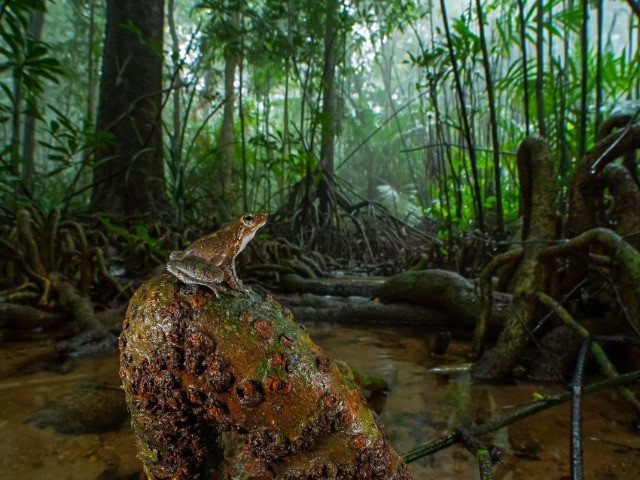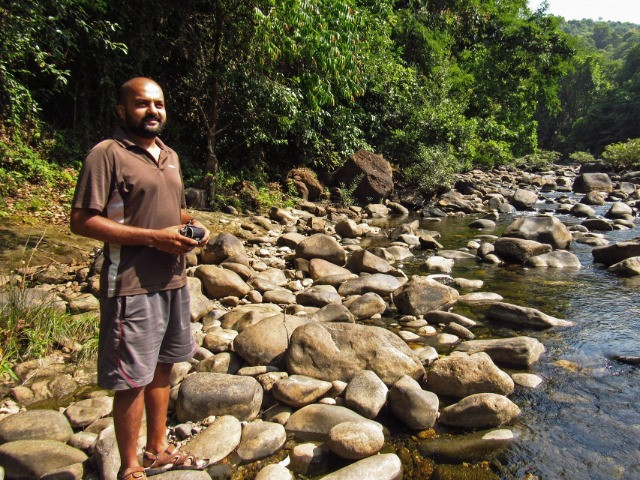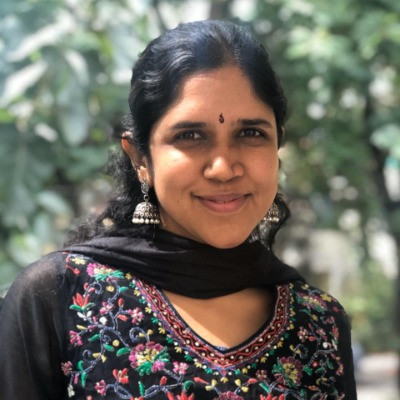Priya Ranganathan dons many hats—a fact that becomes evident within the first ten minutes you spend talking to her.
On her blog (aptly titled On Life and Wildlife), she introduces herself as a wetland ecologist and geologist, primarily focused on the wetland and riverine systems in the Western Ghats of India. But, Ranganathan is also an ardent science educator, an active voice for wetland conservation, a storyteller and a Bharatanatyam dancer. The young researcher shows the world that it is possible to do it all and do it well!
Currently pursuing her PhD in ATREE (Ashoka Trust For Research In Ecology & The Environment), Ranganathan's research focuses on freshwater systems and the human connection to them. Just like her life, her research is also about balancing very different ecosystems—urban lakes and the Myristica swamps of the Western Ghats. But, she will tell you more about that herself. Wetlands and water bodies have always been an integral part of her life, shares Ranganathan, as she talks about her research career. Having roots in the city of Mumbai, mangroves were a constant topic on her mind, and today, when she stands under the dense canopies of the Western Ghats looking at the Myristica swamps, she feels at home.
On World Water Day, we share an edited excerpt of our conversation with Priya Ranganathan, where she talks about her passion for wetland conservation, her research and other initiatives, and her trips to the magical world of the Myristica swamps. Buckle up!
How did you get interested in the conservation of wetland ecosystems? Could you take us through your academic journey?
I started my academic journey with a Bachelor's in Geology, and there I learnt a lot about hydrology, river processes and the importance of landscapes. My Master's was in Environmental Management, where I focused on landscape ecology and conservation management. My course work helped me realise that one cannot look at ecosystems in isolation; you have to look at what is connected to them to understand the bigger picture and the surrounding issues. During my Master's, I was able to use the fundamental knowledge that I gained in geology and add a lot of wildlife science as well as conservation principles to it. I also joined the Centre For Wildlife Studies (CWS), where I focused on the interactions between people and large carnivores. I then moved to conservation education with Wild Shaale (a program by CWS). Although it does look like a lot of changes, at the heart of what I was doing was looking at how people and landscapes interact with each other and trying to unearth those connections.
I came to ATREE to explore interdisciplinarity research and eventually began my PhD with Dr Jagdish Krishnaswamy and Dr G Ravikanth. Dr Krishnaswamy was doing a project on habitat suitability for Gharials in the Gandak river, which is a tributary of the Ganges. Although we were exploring habitat suitability, I was curious to see how people fit into the equation. That is when Dr Krishnaswamy pointed out that I may have a penchant for ecosystem services.
I talked about the mangroves that were a big part of my life being from Mumbai, and it felt like my work was coming full circle. That is how I decided to pursue wetlands. When I recount this journey, it does feel like a funny jump from wildlife to wetlands, and many people have asked me about it. The fact that wetlands are living entities that are dramatically affected by anthropogenic and environmental factors and provide a wide array of services to the people around them—this is what drew me to them. I found these nuances fascinating, and I learn so much every single day!
As we have this conversation, a recent news article highlights Bangalore's lake loss and its severe consequences as an example of how water-stressed our cities are. According to you, how did we get here, and what can we do to fix our past mistakes?
I think one of our biggest wrongdoings was considering groundwater an infinite resource. As it is not a visible entity, people may have taken it for granted and did not realise that the water table fluctuates seasonally. This understanding could have led us to be more responsible about our developmental activities and would have made us mindful about groundwater recharge. For example, when we place concrete surfaces close to a wetland, we leave no room for flooding, for the water to seep into the soil. So, on one hand, we have made it difficult to recharge groundwater, and on the other hand, we have reduced the water levels by extracting too much. We were callous about how we used water and what we took from our natural resources. The combined impact of these activities has led us down the path of creating water-stressed cities. We definitely need greater awareness of our water systems to fix the fundamental issue.
You are also an active part of ATREE's social media messaging on water and wetland conservation. How do you think these messages should be designed for effective communication and awareness building?
That's a great question, and just yesterday, I was talking to the Comms (Communications) team about how we should probably pick up new-age messaging formats to reach out to the right audience. I really want young adults to engage with these messages, and I want them to become more aware. I think visual content in the form of short documentaries or simple short video clips would be ideal for getting their attention. I want to focus on content that showcases the people dependent on these wetlands; the fishers, the nearby communities etc. Such visuals have a significant impact on the younger generation. Sadly, people don't read anymore, so we have to work around and use impactful visual formats.
In Bangalore, communities have done a great job of making lakes and other wetlands into accessible common areas. There are parks, walking trails and playgrounds for children. But despite all that, you would be surprised to see how disconnected people, especially the younger generations, are from these ecosystems. Only when they notice that these ecosystems are worth protecting will they feel the need to act. So beyond social media messaging, I want to encourage them to explore the wetlands. They should want to spend their free time near lakes, and they should be the ones talking about the water bodies on social media. Only then will we see a drastic change in their behaviours, and a change in the way people approach wetlands. So that is what I really want to do; I don't know, maybe start a 'Make wetlands cool again' campaign. (Laughs) Not sure if that will work, though!
You may also like to read
Please tell us a little bit about your research. How do you draw parallels between the diametrically different water bodies that you are studying—the urban lakes and the Myristica swamps of the Western Ghats?
As you rightly said, I focus on two very different wetlands—the urban lakes of Bangalore and the Myristica swamps of the Western Ghats. One is part of a bustling city, and the other is completely natural and a relic from the pre-cretaceous periods. It is a strange dichotomy, but a common thread between the two is that they were both once well-connected systems. Landscape fragmentation is a significant issue with both these ecosystems, leading to a loss in connectivity. This has also substantially impacted the services that people get from these wetlands and the biodiversity they support. In short, I explore these vastly different ecosystems using the theme of hydrological connectivity and its loss over time due to various factors.
I have been fascinated by the Myristica swamps ever since I learnt about them. Along with Aravind N A and Gudasalamani Ravikanth, I wrote a review paper on the myristica swamps and found that the existing research has not looked into the services provided by these wetlands. Tangible measures of how people relate to them are largely missing. Oddly enough, this is also true for urban lakes. For example, how do people who live in high-rise buildings near lakes relate to these water systems? There is a gap in our understanding. We need to explore the whole gamut of services they provide, which extends from the traditional usage of Myristica swamps to the urban lakes adding aesthetic value in people's lives. I look at these connections across three categories—provisional, recreational, and cultural. What I hope to do is to make people aware of the fact that they have a much closer connection to these ecosystems than they realise.
Give us a sneak peek of what your typical day looks like when you are on the field or off-field.
When there is fieldwork, the day starts early, maybe around five. I head out to the swamps and meet up with my field assistants. We use the early hours to document the area's biodiversity, especially the birds. Many of the locals are also around at the time, collecting water or stopping by the swamps before they head to their fields. We also try to converse with them and ask them about the benefits they receive from the ecosystem.
We then collect water and soil samples, which are taken back to the field station for analysis. In the afternoon, we sit and talk to the stakeholders—the villagers and other community members—asking them how they think the swamps need to be protected. We also interact with people from the forest department and get their inputs and insights. When possible, I try to shoot short video clips of people at work near the Myristica swamps. In the evening, we do another round of biodiversity checks and then go back to the station to collate data.
With urban lakes, the whole process is a bit different, because fishers are out in the lakes till about eleven in the morning. We get to the lakes in the morning and interact with them to understand what species they are catching the most, what is popular in the market, and we ask questions that give us some idea about their relationship with the lake beyond their fishing activities. Many of the lakes have managers and we talk to them about the involvement of local communities in activities of lake conservation. We also collect water and soil samples and document the biodiversity of the area. So some aspects are very similar to what we do when studying the Myristica swamps, but the swamp visits are far more intense.
My off days are mostly about PhD coursework which takes up a lot of my time. I also run a magazine called Youth For Nature. After all that, if there is free time available, I try to practice Bharatanatyam. That's what my life looks like at the moment in a nutshell.
Please tell us about Youth for Nature and your other initiative, Wetlands of India.
Youth For Nature is a free digital magazine for children and people interested in science. Our goal is to get young readers to engage with nature. We share informative pieces that use illustrations and other means to make the content accessible for children. We also highlight the wildlife in India and shine a spotlight on various species. To encourage kids to go out and observe the biodiversity around them, we publish exciting safari encounters and share experiences of wildlife photographers. We also have a section where parents will find stories that they can read out to their children. These stories are centred around children interacting with nature and influenced by the works of Ruskin Bond.
I run Wetlands Of India with Shivona Bhojwani. She is doing her PhD in Conservation Science at the University of Minnesota. We are trying to raise awareness about the many wetlands found in India and the biodiversity they support. We want to showcase the vast array of wetlands beyond the RAMSAR sites. Although work is a bit slow on this front, we are currently working on the next set of posts. We hope that people will also contribute their wetland sightings, adding to the information as the project grows.
How can we encourage more women in ecological sciences and research?
What surprises me are some of the patriarchal notions that are still so prevalent. We still get questions and comments like 'How are you going to manage fieldwork?' 'How will you walk X km for your research?' 'You can't work in a forest!' 'You can't stay out in the sun for too long!' These thoughts clearly outline that the field is considered to be suitable only for men. So many people seem to think that it would be best if women stuck to lab-based research or social science surveys. This is appalling as it makes many women second-guess their capabilities and reinforces stereotypes. We all rely on nature, and we all expect clean air and water where we live. And women often take on the onus of keeping a check on the entire family's health. So why is it different when they decide to focus on working for a better environment where everyone can thrive? I think we really need to think about the broader issues to move away from these age-old notions. And to do that, we need to build awareness about what is important. What is happening to our planet and why do we all need to partake in making things better!
Also, as women in STEM, we really need to support and uplift each other. We need to reinforce confidence among our peers when they feel frustrated. I think it is very important to have that ecosystem of support.











